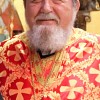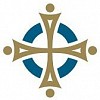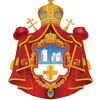WEEKLY THEME: TWENTY YEARS SINCE THE POGROM IN KOSOVO AND METOHIJA
The Awarded Crime
The Serbian St. Bartholomew's Night
By Živojin Rakočević
Sunday, March 17, 2024
Everything that belonged to the Serbs was struck at the heart. From the brilliant achievements of the Middle Ages to isolated elderly in towns, an entire civilization was afflicted. A pogrom occurred, or the Serbian St. Bartholomew's Night. Never in its history had the Serbian Orthodox Church suffered such a severe blow in such a short time. Fatal violence killed people, changed the political status, eliminated urbanity, prevented the return of the displaced, destroyed old books, schools, and libraries, urban environments and villages, intangible heritage and language, cemeteries and monuments, even hung animals, and widely opened the doors to the violent acceptance of foreign ethnic freedom. The pogrom marked the lives of 120,000 Serbs, Gorani, Roma, Ashkali with fear and turned into one of those fatal turning points in our history from which time is sometimes counted. It completed the process of ghettoization and deurbanization of the Serbs. Fear became a way of life, and enduring and waiting for freedom the only possible model of survival. It reminded Serbs in the world and the region of Kosovo as a place of suffering and, to a large extent, shook faith in European values.
The organizers of justice were untouched, some perpetrators were tried and received, according to OSCE conclusions, disproportionately light sentences. Kosovo police officers who, in many cases, provided logistics to arsonists and murderers, expelled Serbs from their homes, and directed the masses went completely unpunished.
Besides the cumbersome, inefficient, uninterested, and, as representatives of the international community said among themselves, Balkanized system that the international community established in Kosovo and Metohija in 1999, three levels of power, administration, and authority developed: supra-institutions, institutions, and sub-institutions. The Quint countries and their embassies in Pristina, led by America, are the supra-institutions; the president, government, municipalities represent visible and formal institutions; traditional tribal and, associated with them, mafia structures and networks constitute sub-institutions.
The consensus of these forces developed through joint action and changing the basic principles of the international community's mission: first standards, then status, later both standards and status, and finally, status without standards.
The pogrom of March 17, 2004, marked the establishment of institutional harmony between these three parallel systems, the abandonment of all standards, and, ultimately, the moment of decision for the international community to fully recognize the independence of Kosovo.
Only such governance could allow and support the false news by Radio Television of Kosovo (RTK) that Serbs had driven Albanian children into the Ibar river with dogs,
where they drowned, and believe the "humanitarian worker" Halit Barani, who created the news and coordinated the media. Similarly, he reported to the world media via satellite phone in 1999 that Serbs were burning Albanians in the high furnaces of the Trepča Combine. Meanwhile, the public service RTK was "punished" for the false news that ignited the chaos by being granted €100,000 for journalist training and professionalization of the house. "What do you want?", echoed the question, repeated several times, in the manor of the Gračanica monastery, posed by the youthful British official John Sawers. "You must accept responsibility, you are responsible," he repeated as he was bombarded with photographs, data, and recordings from the field by Oliver Ivanović, Father Sava Janjić, and the author of this text, while the smell of burning was literally felt on the street. The lingering question was: how is it possible that we are responsible for being killed? The fire had not even extinguished when the international community decided to recognize the independence of Kosovo and calm its own fears that this ethnic turmoil could turn against them. Naive was also the assumption that rewarded Albanian nationalism would keep under control the destructive Islamic potential of the Albanians. It was decided to give chaos its final form, and the members of the executioner tribe, the mass, as mere executors of the national job in the pogrom, according to OSCE data, remained largely unpunished. This fatal moment of final confrontation was almost prepared by everyone, so even the most liberal Albanian newspaper "Koha Ditore" called for lynching before the pogrom with the words: "The same Serbs coming to Kosovo from the remnants of the Belgrade criminal regime have no right to life in Kosovo and represent a legitimate target for attacks."
Western democracies and their most important on-the-ground exponents decided to recognize ethnocracy and thus, paradoxically, solidified the idea among both Serbs and Albanians that crime pays off and is rewarded.
The Destruction of Prizren
"Bilbil bird, do not sing early, do not wake my master," sang old lady Natalija Krstić, born in the first year after the Great War, on her iron bed. All her life, she sang old Kosovo songs, and she sang them in the gathering center of the last Serbs in Prizren. She fled from the Seminary, where Dragan Nedeljković was burning, and hid around the city until a military transporter brought her to the German KFOR camp.
What master was she afraid of as she barefoot hid under the bridges of Prizren to await the dawn and to sing again in this obscure place? Who was and remained the real master of Prizren? The city of three languages, three cultures, a city of Orthodox, Catholic, and Oriental dominion, was dealt a death blow. Everything that belonged to the Serbs was destroyed. Orthodoxy, in no other city of ours, had been in such a symbiosis with urbanity; no other city had such a long history of relations with Orthodoxy, nowhere among Serbs did Christianity live so intimately and naturally, in all times. Those small churches were a family matter. They were so ordinary and urban, their walls leaned against shops and small stores, their outer walls were actually the inner walls of poor rooms and houses. It all seemed as though it was under one roof. Prizren was left without a roof.
The March pogrom is a cycle of violence that killed towns and everything urban, town-like, semi-urban, oriental, and small-town in the lives of Serbs in Kosovo and
Metohija. The last Serbs in the cities, until the pogrom, preserved local dialects, beliefs, traditions, songs, urban legends, costumes, ways of living, memories of crafts, and unique people. Disappearance was legalized, and when making decisions, the powerful centers of politics were not bothered by the question: how did you recognize the ethnically cleanest city in Europe as the capital of Kosovo? Paradoxically, the destruction of the Serbian civilization and life has made it easier and freer today to talk about the Kosovo cultural identity as a category that transcends national affiliations and peculiarities. The question remains: why burn and demolish if it's your heritage and if these are your sanctuaries?
The Disappearance of the Weakest
"I'm not entirely clear why the Ashkali settlement in Vučitrn was destroyed in that manner," wondered one of the high-ranking American officials who came to "assess the causes and review the results so far" of the international presence.
"Sir, history here, you know, is a bit complicated, and you seem not to be familiar with the period when the Ashkali minority governed Kosovo: that was a period of the darkest terror, Ashkali police, army, administrative apparatus, and then the Ashkali language as the only official language, a terrible repression in which Albanians suffered immensely," was one of the responses.
The interlocutor, accustomed to such simplified matrices, hardly noticed the cynicism. In the general chaos, even the unfortunate Ashkalis, an ethnic group of Roma who speak the Albanian language, went almost unnoticed.
Their properties were destroyed to the last stone, and today, concrete beams testify to their presence, the only remnants of their homes.
Even though they fled into a new identity after 1999, even though they hid in language, loyalty, and behavior, they failed to preserve themselves: evil discovered and obliterated them, almost without a trace. The Serbs were expelled from Vučitrn in 1999. Behind them remained the old cemetery and the Church of Saint Elijah. The pogrom burned and destroyed all of it, and priest Bogomir Stević found vandalized graves and scattered bones of the deceased.
The last material and spiritual segments of the city vanished, just as here, five years earlier – seemingly forever – journalist Ljubomir Knežević, correspondent of "Politika," disappeared.
Frescoes, Icons, Paintings
The most catastrophic and severe blow was dealt to the most valuable frescoes in the Church of the Holy Virgin of Ljeviška. The "Voice of the South" team recorded and photographed the remnants of car tires and oil barrels, whose burning a few days earlier turned monumental portraits of Serbian and European medieval art into stains. The brilliance and light that emerged after the mid-20th century restoration and the removal of Ottoman plaster once again sank into darkness and evil.
The "wounded torsos of beauty," as Dušan Matić called them, disappeared again, and the Christ of Prizren and the Virgin with a basket, nurturers of the poor, suffered severely from soot and high temperatures. Frescoes in the churches of Prizren, some restored, some with burned pigments, today look like gravely ill patients, bloodless and
exhausted. Thousands of icons perished in the pogrom: all the effort, love, donations, and prayers that the citizens of Prizren had given, infused, and consecrated to the Church of Saint George vanished along with the collection of icons, frescoes, and an iconostasis brought from Szentendre. Everything under the responsibility of the German KFOR was completely destroyed and devastated, and the German magazine "Der Spiegel" called its soldiers the rabbits of Kosovo.
Only stains on the walls and some older, crudely made saint figures emerged from the bare and ruined walls of the Church of Saint Nicholas in Priština. A vast number of icons were looted and ended up on the black market. The fundamental problem is that we will never know what each church possessed. Many icons or paintings donated to the churches were not recorded and professionally processed, so there is no trace of them.
For example, paintings by Uroš Predić disappeared from the Church of Saint Archangel Michael in Štimlje. They were either carried off or destroyed by the evil of the pogrom.
In neighboring Uroševac, from the Church of Saint Emperor Uroš, a collection of icons disappeared, among them the Holy Trinity, painted in 1896 by "Josif Radevič from Lazaropolje for the grain merchants."
The same fate befell the collection of 18th and 19th-century icons in the Church of the Assumption of the Holy Virgin in Đakovica, on the backs of which were numerous records and inscriptions significant for our language and philology. What was in the Church of Saint Elijah in Podujevo is no longer remembered by anyone.
The Charred Angel
Wood Carving, Iconostases Wood carvings, iconostases, and church furniture were burned, destroyed, plundered, or demolished in temples and facilities in Kosovska Mitrovica, Prizren, Štimlje, Vučitrn, Uroševac, and other places affected by the pogrom, with the most important and valuable iconostasis in Priština being completely destroyed. This exceptional work, created in master workshops in Debar, surpassed the limitations of ornaments and common motifs, approaching an original artistic achievement. Its authors, three brothers who modestly depicted themselves at the lowest place, above the floor, spent years sculpting these figures and compositions in wood, creating a successful and unusual whole for the temple of the Serbs in Priština. This wood carving spoke hundreds of feelings, presented many Old Testament and New Testament themes and motives, expressing everything that the Christian population of the Ottoman Empire secretly confessed and hoped for. The temple's roof fell on the iconostasis, so the artwork burned for days, and blue flames burst from beneath the rubble and under the soles of us who came to the Church of Saint Nicholas in those days.
"I gave Mr. Johnson a piece of the burned cross from the Priština church – it's a charred angel – to remind him, as a pledge, of everything that happened here. The greatest sanctities of Orthodox art are being destroyed here," Father Sava Janjić told Gregory Johnson, the commander of NATO's southern wing. He promised to stand against evil and added that he had unsuccessfully tried to establish contact with Ramush Haradinaj, the war commander of the KLA and later a political leader of the Kosovar Albanians, during the three days of the pogrom. In this "communication breakdown," angels and art burned, lives and cities disappeared. There is no precise record of what all
was lost and destroyed in this area. Who will remember the burned iron bed of King Alexander the Unifier, on which he slept the last nights before setting off from the "Saints Cyril and Methodius" Seminary into the ice of the Accursed Mountains and the Albanian mountains?
Books and Libraries
A section of the cobblestoned street in the old Potkaljaja neighborhood in Prizren was buried under books. Some were half-burned, some wet, some covered with tiles and plaster. Children's literature, history, fiction... A collection of stories by Grigorije Božović, "Uninvented Characters," swollen from moisture, lay in the middle of the street. Water pipes burst due to the fire "saved" this private library of an unknown owner, which, along with the home, spilled out onto the stone cubes. Later, armies and "restorers" of this neighborhood threw everything except "Uninvented Characters" into the local landfill. No one will ever know what and which books burned in the Church of Saint Sava in the southern part of Kosovska Mitrovica, and what went up in smoke in the episcopal residence and the "Saints Cyril and Methodius" Seminary, in the Monastery of the Holy Archangels in Kosovo Polje, in the "Saint Sava" Elementary School, in the high school center in Obilić, in the church in Podujevo...
"These books were sent to the Serbian poor of Priština by the Russian Empress Catherine, long before the Serbs begged the Turkish authorities to build the church," Father Miroslav Popadić told rare visitors, bringing out the gospels of Catherine the Great from the altar. Smoke and the fire of the pogrom forced him to wait for death or the army to rescue him in the basement of his home. Fortunately, he was rescued at the last moment with nothing in his hands. The parochial and personal library, and those imperial gospels, were turned to ash by evil.
Indeed, that book had built the temple, just as the songs of Dubrovnik's Andrija Kačić Miošić, which were hand-copied by a teacher from Đakovica during the worst position of Christians in Turkey, preserved to this day as the greatest sanctuary and pledge that freedom comes. Not a single book survived the pogrom in the church in Đakovica, nor in Serbian Street in this city.
Cemeteries
The most drastic example of the systematic destruction of cemeteries during the pogrom is the monastic cemetery of the Devič Monastery in Drenica. Albanians demolished and crushed every tombstone into almost tiny pieces. This likely occurred the day after the looting and destruction of the monastery. On that day, it was impossible to destroy the graves in such a manner due to smoke and fire, and those days saw the beginning of the removal of stones from the monastery walls, as well as the cutting of trees and fruit trees. The mob that burned down the Serbian returnee village of Belo Polje, whose leader was killed by shots from a pistol by an American policewoman, turned from the village towards the cemetery, opening, breaking, and pulling out old tomb crosses from the ground. Paradoxically, later attempts were made to erect a memorial for the "hero" who was killed, right at the place of his death, between the village and the church they burned and the cemetery they destroyed. At the old cemetery near the Church of Saint Nicholas in Priština, most crosses were broken, and marble slabs
covering the graves were collapsed and fell on the mortal remains. A similar situation was observed at the new large city cemetery: "Dear passersby, these are Albanians from the south. Please do not desecrate!" noted Professor Mitra Reljić, after the pogrom, a message to her Albanian compatriots. In the completely burned-down Monastery of the Holy Archangels near Prizren, attempts were made with metal bars to remove and break the heavy stone slab on either side of Emperor Dušan's burial site, which did not suffer major damage. The exact number of tombstones destroyed in the turmoil will never be determined. The monastic cemetery in Devič has been restored, while most of the desecrated, destroyed, overgrown, plowed, and buried cemeteries from 1999 to today have not been restored.
Animals
As the flame-engulfed bell tower of the Holy Virgin of Ljeviška swayed over Prizren, and barrels of oil and car tires turned the genius strokes of a medieval painter in the temple to dust, teacher Dobrila Dolašević was trying to survive a lynching. The elderly woman was beaten, strangled, and her home set on fire, and evil bore the faces of some of her students. She didn't regret anything, she says, nor felt humiliated: "I feel sorry for the cat. What a cat it was! It stayed with me all the time, didn't leave me while they were hitting me!" In the German army camp, Dobrila says she feels sorry for the animal that had to see her like that, sorry that the cat, most likely suffocated in the smoke, again because of her, remained in their shared home. On her iron bed lies an open book by Pavić, "The Last Love in Constantinople." The old lady says goodbye to all her loves and to her city life so far.
The first onslaught of the mob left almost nothing behind. Animals that were not stolen were killed in stables, courtyards, houses: livestock and poultry in Čaglavica near Priština, in Svinjare near Kosovska Mitrovica, where, according to a Human Rights Watch report, French soldiers from the KFOR camp, a few hundred meters away, refused to help the Serbs; the killing of dogs in the Devič Monastery, Lipljan, and Gnjilane was recorded.
In Obilić, from 1999 to the pogrom, only the most enduring and those brave enough to stay in the city after the massacre of the elderly Stolić family (2003) remained. The pogrom finally broke them, literally to the last: the church, the school center, the only building, and house by house.
On the edge of one of the settlements, on scaffolding that the owner had put up to repair his poor house, an Albanian crowd hanged a pig. They threw a rope around its neck, pulled it over a metal bar, and killed it. They left it hanging as a bizarre message to both the owner and the Serbs of Obilić.
The Phenomenon of Evil
Belgrade's politics has mostly experienced failures on both the domestic and international fronts, temporarily and formally postponing the capitulation before chaos. It often sought solutions with those who undermine and take away the foundations of culture, identity, emotions, spirituality, and statehood. This policy, for fifteen years now, often resembles Toma Milosavljević from Lipljan, one of the heroes of the pogrom. When the Albanian mob attacked his home at night, he, with a knitted cap pulled over his
head, ran inside with the arsonists, breaking things he had acquired throughout his life and watching his “comrades” do the same.
"One hit the picture of my youngest son with a shovel. It was on the wall. My heart trembled," Toma testified. When they set fire to the curtains, scattered papers, and family photos, the vandals fled from the fire, but Toma stayed to extinguish it. In one of the later waves of the turmoil, his home was burned down. All he was left with were severe burns on his hands and a black mark where his estate, into which he had invested his entire life, once stood. Yet, he was not driven away: he returned and rebuilt what he could and what he was given, forced into a new context and someone else's freedom. The Serbian Orthodox Church also returned, and on many burnt sites, raised walls, placed roofs, restored frescoes, installed priests, and, to some extent, began the reconstruction of life and protection from evil and disappearance.
The phenomenon of evil in Kosovo and Metohija, however much it seems forgotten, is a stain and loss to the modern world. The bell ringing in Podujevo, near the crossing, in the fire of the pogrom, as a young man jumps and knocks down the cross on the dome of the church, is heard even by those Albanians who today flee to the West due to a life made meaningless and insecurity.
|
| |||||||||||




